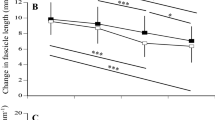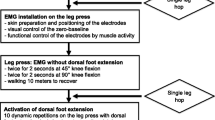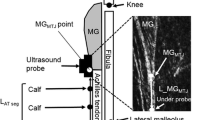Abstract
Purpose
The present study examined the effects of repetitive hopping training on muscle activation profiles and fascicle–tendon interaction in the elderly.
Methods
20 physically active elderly men were randomly assigned for training (TG) and control groups (CG). TG performed supervised bilateral short contact hopping training with progressively increasing training volume. Measurements were performed before the training period (BEF) as well as after 2 weeks (2 W) and 11 weeks (11 W) of training. During measurements, the gastrocnemius medialis–muscle (GaM) fascicle and its outer Achilles tendon length changes during hopping were examined by ultrasonography together with electromyographic (EMG) activities of calf muscles, kinematics, and kinetics.
Results
At 2 W, the ankle joint stiffness was increased by 21.0 ± 19.3 % and contact time decreased by 9.4 ± 7.8 % in TG. Thereafter, from 2–11 W the jumping height increased 56.2 ± 18.1 % in TG. Simultaneously, tendon forces increased 24.3 ± 19.0 % but tendon stiffness did not change. GaM fascicles shifted to shorter operating lengths after training without any changes in their length modifications during the contact phase of hopping. Normalized EMG amplitudes during hopping did not change with training.
Conclusions
The present study shows that 11 W of hopping training improves the performance of physically active elderly men. This improvement is achieved with shorter GaM operating lengths and, therefore, increased fascicle stiffness and improved tendon utilization after training. Based on these results, hopping training could be recommended for healthy fit elderly to retain and improve rapid force production capacity.






Similar content being viewed by others
Abbreviations
- AJS:
-
Ankle joint stiffness
- ATF:
-
Achilles tendon force
- BEF:
-
Baseline (first) measurement session before training
- CG:
-
Control group
- EMG:
-
Electromyography
- Fz:
-
Vertical component of the ground reaction force
- GaL:
-
Gastrocnemius lateralis muscle
- GaM:
-
Gastrocnemius medialis muscle
- GRF:
-
Ground reaction force
- KJS:
-
Knee joint stiffness
- MTU:
-
Muscle–tendon unit
- MTJ:
-
Muscle–tendon junction
- MVC:
-
Maximal voluntary contraction
- RMS:
-
Root mean square
- RSI:
-
Reactive strength index
- SOL:
-
Soleus muscle
- TA:
-
Tibialis anterior muscle
- TG:
-
Training group
- 2 W:
-
Second measurement session after 2 weeks of training
- 11 W:
-
Third and last measurement session after 11 weeks of training
References
Andersen JL (2003) Muscle fibre type adaptation in the elderly human muscle. Scand J Med Sci Sports 13:40–47
Arampatzis A, Karamanidis K, Albracht K (2007) Adaptational responses of the human Achilles tendon by modulation of the applied cyclic strain magnitude. J Exp Biol 210:2743–2753. doi:10.1242/jeb.003814
Arampatzis A, Peper A, Bierbaum S, Albracht K (2010) Plasticity of human Achilles tendon mechanical and morphological properties in response to cyclic strain. J Biomech 43:3073–3079. doi:10.1016/j.jbiomech.2010.08.014
Aura O, Komi PV (1986) Effects of prestretch intensity on mechanical efficiency of positive work and on elastic behavior of skeletal muscle in stretch-shortening cycle exercise. Int J Sports Med 7:137–143. doi:10.1055/s-2008-1025751
Barber LA, Barrett RS, Gillett JG, Cresswell AG, Lichtwark GA (2013) Neuromechanical properties of the triceps surae in young and older adults. Exp Gerontol 48:1147–1155. doi:10.1016/j.exger.2013.07.007
Beijersbergen CM, Granacher U, Vandervoort AA, DeVita P, Hortobagyi T (2013) The biomechanical mechanism of how strength and power training improves walking speed in old adults remains unknown. Ageing Res Rev 12:618–627. doi:10.1016/j.arr.2013.03.001
Bosco C, Ito A, Komi PV et al (1982) Neuromuscular function and mechanical efficiency of human leg extensor muscles during jumping exercises. Acta Physiol Scand 114:543–550
Candow DG, Chilibeck PD (2005) Differences in size, strength, and power of upper and lower body muscle groups in young and older men. J Gerontol A Biol Sci Med Sci 60:148–156
Chimera NJ, Swanik KA, Swanik CB, Straub SJ (2004) Effects of Plyometric Training on Muscle-Activation Strategies and Performance in Female Athletes. J Athl Train 39:24–31
Clark DJ, Manini TM, Fielding RA, Patten C (2013) Neuromuscular determinants of maximum walking speed in well-functioning older adults. Exp Gerontol 48:358–363. doi:10.1016/j.exger.2013.01.010
Farris DJ, Trewartha G, McGuigan MP (2012) The effects of a 30-min run on the mechanics of the human Achilles tendon. Eur J Appl Physiol 112:653–660. doi:10.1007/s00421-011-2019-8
Finni T, Komi PV, Lepola V (2001) In vivo muscle mechanics during locomotion depend on movement amplitude and contraction intensity. Eur J Appl Physiol 85:170–176
Finni T, Hodgson JA, Lai AM, Edgerton VR, Sinha S (2003) Nonuniform strain of human soleus aponeurosis-tendon complex during submaximal voluntary contractions in vivo. J Appl Physiol 95:829–837. doi:10.1152/japplphysiol.00775.2002
Flanagan EP, Ebben WP, Jensen RL (2008) Reliability of the reactive strength index and time to stabilization during depth jumps. J Strength Cond Res 22:1677–1682. doi:10.1519/JSC.0b013e318182034b
Hakkinen K, Komi PV (1983) Electromyographic changes during strength training and detraining. Med Sci Sports Exerc 15:455–460
Häkkinen K, Alen M, Kallinen M, Izquerdo M, Jokelainen K, Lassila H, Mälkiä E, Kraemer WJ, Newton RU (1998) Muscle CSA, force production, and activation of leg extensors during isometric and dynamic actions in middle-aged and elderly men and women. J Aging Phys Act 6:232–247
Hansen P, Aagaard P, Kjaer M, Larsson B, Magnusson SP (2003) Effect of habitual running on human Achilles tendon load-deformation properties and cross-sectional area. J Appl Physiol 95:2375–2380. doi:10.1152/japplphysiol.00503.2003
Hawkins D, Hull M (1990) A method for determining lower extremity muscle-tendon lengths during flexion/extension movements. J Biomech 23(5):487–494
Hermens HJ, Freriks B, Merletti R, Hägg G, Stegeman D, Blok J (eds) (1999) SENIAM 8: European recommendations for surface electromyography. Roessingh Research and Development bv
Hoffren M, Ishikawa M, Komi PV (2007) Age-related neuromuscular function during drop jumps. J Appl Physiol 103:1276–1283. doi:10.1152/japplphysiol.00430.2007
Hoffren M, Ishikawa M, Rantalainen T, Avela J, Komi PV (2011) Age-related muscle activation profiles and joint stiffness regulation in repetitive hopping. J Electromyogr Kinesiol 21:483–491. doi:10.1016/j.jelekin.2011.01.009
Hoffren M, Ishikawa M, Avela J, Komi PV (2012) Age-related fascicle–tendon interaction in repetitive hopping. Eur J Appl Physiol 112:4035–4043. doi:10.1007/s00421-012-2393-x
Hortobagyi T, DeVita P (2000) Muscle pre- and coactivity during downward stepping are associated with leg stiffness in aging. J Electromyogr Kinesiol 10:117–126
Houghton LA, Dawson BT, Rubenson J (2013) Effects of plyometric training on achilles tendon properties and shuttle running during a simulated cricket batting innings. J Strength Cond Res 27:1036–1046. doi:10.1519/JSC.0b013e3182651e7a
Hunter SK, Thompson MW, Adams RD (2000) Relationships among age-associated strength changes and physical activity level, limb dominance, and muscle group in women. J Gerontol A Biol Sci Med Sci 55:B264–B273
Karamanidis K, Arampatzis A (2005) Mechanical and morphological properties of different muscle–tendon units in the lower extremity and running mechanics: effect of aging and physical activity. J Exp Biol 208:3907–3923
Komi PV, Gollhofer A, Schmidtbleicher D, Frick U (1987) Interaction between man and shoe in running: considerations for a more comprehensive measurement approach. Int J Sports Med 8:196–202
Kubo K, Kanehisa H, Fukunaga T (2001) Effects of different duration isometric contractions on tendon elasticity in human quadriceps muscles. J Physiol 536:649–655
Kubo K, Kanehisa H, Miyatani M, Tachi M, Fukunaga T (2003) Effect of low-load resistance training on the tendon properties in middle-aged and elderly women. Acta Physiol Scand 178:25–32
Kubo K, Kanehisa H, Fukunaga T (2005) Effects of cold and hot water immersion on the mechanical properties of human muscle and tendon in vivo. Clin Biomech 20:291–300
Kubo K, Ohgo K, Takeishi R et al (2006) Effects of isometric training at different knee angles on the muscle–tendon complex in vivo. Scand J Med Sci Sports 16:159–167. doi:10.1111/j.1600-0838.2005.00450.x
Kubo K, Morimoto M, Komuro T et al (2007) Effects of plyometric and weight training on muscle–tendon complex and jump performance. Med Sci Sports Exerc 39:1801–1810. doi:10.1249/mss.0b013e31813e630a
Kubo K, Ikebukuro T, Maki A, Yata H, Tsunoda N (2012) Time course of changes in the human Achilles tendon properties and metabolism during training and detraining in vivo. Eur J Appl Physiol 112:2679–2691. doi:10.1007/s00421-011-2248-x
Kuitunen S, Komi PV, Kyrolainen H (2002) Knee and ankle joint stiffness in sprint running. Med Sci Sports Exerc 34:166–173
Kuitunen S, Kyrolainen H, Avela J, Komi PV (2007) Leg stiffness modulation during exhaustive stretch-shortening cycle exercise. Scand J Med Sci Sports 17:67–75
Kyrolainen H, Takala TE, Komi PV (1998) Muscle damage induced by stretch-shortening cycle exercise. Med Sci Sports Exerc 30:415–420
Kyrolainen H, Avela J, McBride JM et al (2004) Effects of power training on mechanical efficiency in jumping. Eur J Appl Physiol 91:155–159. doi:10.1007/s00421-003-0934-z
Kyrolainen H, Avela J, McBride JM et al (2005) Effects of power training on muscle structure and neuromuscular performance. Scand J Med Sci Sports 15:58–64. doi:10.1111/j.1600-0838.2004.00390.x
Lanza IR, Towse TF, Caldwell GE, Wigmore DM, Kent-Braun JA (2003) Effects of age on human muscle torque, velocity, and power in two muscle groups. J Appl Physiol 95:2361–2369. doi:10.1152/japplphysiol.00724.2002
LaRoche DP, Cremin KA, Greenleaf B, Croce RV (2010) Rapid torque development in older female fallers and nonfallers: a comparison across lower-extremity muscles. J Electromyogr Kinesiol 20:482–488. doi:10.1016/j.jelekin.2009.08.004
Lichtwark GA, Wilson AM (2005a) In vivo mechanical properties of the human Achilles tendon during one-legged hopping. J Exp Biol 208:4715–4725. doi:10.1242/jeb.01950
Lichtwark GA, Wilson AM (2005b) Effects of series elasticity and activation conditions on muscle power output and efficiency. J Exp Biol 208:2845–2853. doi:10.1242/jeb.01710
Liu Y, Schlumberger A, Wirth K, Schmidtbleicher D, Steinacker JM (2003) Different effects on human skeletal myosin heavy chain isoform expression: strength vs. combination training. J Appl Physiol 94:2282–2288. doi:10.1152/japplphysiol.00830.2002
Magnusson SP, Hansen P, Aagaard P et al (2003) Differential strain patterns of the human gastrocnemius aponeurosis and free tendon, in vivo. Acta Physiol Scand 177:185–195
Malatesta D, Simar D, Dauvilliers Y et al (2003) Energy cost of walking and gait instability in healthy 65- and 80-yr-olds. J Appl Physiol 95:2248–2256
Malisoux L, Francaux M, Nielens H, Theisen D (2006) Stretch-shortening cycle exercises: an effective training paradigm to enhance power output of human single muscle fibers. J Appl Physiol 100:771–779. doi:10.1152/japplphysiol.01027.2005
Mian OS, Thom JM, Ardigò LP, Narici MV, Minetti AE (2006) Metabolic cost, mechanical work, and efficiency during walking in young and older men. Acta Physiol (Oxf) 186:127–139
Mian OS, Thom JM, Ardigo LP, Minetti AE, Narici MV (2007) Gastrocnemius muscle–tendon behaviour during walking in young and older adults. Acta Physiol (Oxf) 189:57–65
Morse CI, Thom JM, Davis MG, Fox KR, Birch KM, Narici MV (2004) Reduced plantarflexor specific torque in the elderly is associated with a lower activation capacity. Eur J Appl Physiol 92:219–226. doi:10.1007/s00421-004-1056-y
Morse CI, Thom JM, Birch KM, Narici MV (2005) Tendon elongation influences the amplitude of interpolated doublets in the assessment of activation in elderly men. J Appl Physiol 98:221–226
Newton RU, Hakkinen K, Hakkinen A, McCormick M, Volek J, Kraemer WJ (2002) Mixed-methods resistance training increases power and strength of young and older men. Med Sci Sports Exerc 34:1367–1375
Norris JA, Granata KP, Mitros MR, Byrne EM, Marsh AP (2007) Effect of augmented plantarflexion power on preferred walking speed and economy in young and older adults. Gait Posture 25:620–627. doi:10.1016/j.gaitpost.2006.07.002
Onambele-Pearson GL, Pearson SJ (2012) The magnitude and character of resistance-training-induced increase in tendon stiffness at old age is gender specific. Age (Dordr) 34:427–438. doi:10.1007/s11357-011-9248-y
Panizzolo FA, Green DJ, Lloyd DG, Maiorana AJ, Rubenson J (2013) Soleus fascicle length changes are conserved between young and old adults at their preferred walking speed. Gait Posture 38:764–769. doi:10.1016/j.gaitpost.2013.03.021
Pearson SJ, Young A, Macaluso A et al (2002) Muscle function in elite master weightlifters. Med Sci Sports Exerc 34:1199–1206
Peltonen J, Cronin NJ, Stenroth L, Finni T, Avela J (2012) Achilles tendon stiffness is unchanged one hour after a marathon. J Exp Biol 215:3665–3671. doi:10.1242/jeb.068874
Peltonen J, Cronin NJ, Stenroth L, Finni T, Avela J (2013) Viscoelastic properties of the achilles tendon in vivo. Springerplus 2:212. doi:10.1186/2193-1801-2-212
Piirainen JM, Cronin NJ, Avela J, Linnamo V (2014) Effects of plyometric and pneumatic explosive strength training on neuromuscular function and dynamic balance control in 60–70 year old males. J Electromyogr Kinesiol 24:246–252. doi:10.1016/j.jelekin.2014.01.010
Pijnappels M, Bobbert MF, van Dieen JH (2005a) How early reactions in the support limb contribute to balance recovery after tripping. J Biomech 38:627–634. doi:10.1016/j.jbiomech.2004.03.029
Pijnappels M, Bobbert MF, van Dieen JH (2005b) Control of support limb muscles in recovery after tripping in young and older subjects. Exp Brain Res 160:326–333. doi:10.1007/s00221-004-2014-y
Rantalainen T, Hoffren M, Linnamo V et al (2011) Three-month bilateral hopping intervention is ineffective in initiating bone biomarker response in healthy elderly men. Eur J Appl Physiol 111:2155–2162. doi:10.1007/s00421-011-1849-8
Reeves ND, Maganaris CN, Narici MV (2003) Effect of strength training on human patella tendon mechanical properties of older individuals. J Physiol 548:971–981. doi:10.1113/jphysiol.2002.035576
Rugg SG, Gregor RJ, Mandelbaum BR, Chiu L (1990) In vivo moment arm calculations at the ankle using magnetic resonance imaging (MRI). J Biomech 23:495–501
Seynnes OR, Koesters A, Gimpl M et al (2011) Effect of alpine skiing training on tendon mechanical properties in older men and women. Scand J Med Sci Sports 21(Suppl 1):39–46. doi:10.1111/j.1600-0838.2011.01340.x
Stenroth L, Peltonen J, Cronin NJ, Sipila S, Finni T (2012) Age-related differences in Achilles tendon properties and triceps surae muscle architecture in vivo. J Appl Physiol 113:1537–1544. doi:10.1152/japplphysiol.00782.2012
Stosic J, Finni T (2011) Gastrocnemius tendon length and strain are different when assessed using straight or curved tendon model. Eur J Appl Physiol 111:3151–3154. doi:10.1007/s00421-011-1929-9
Taube W, Leukel C, Lauber B, Gollhofer A (2012) The drop height determines neuromuscular adaptations and changes in jump performance in stretch-shortening cycle training. Scand J Med Sci Sports 22:671–683. doi:10.1111/j.1600-0838.2011.01293.x
Van Cutsem M, Duchateau J, Hainaut K (1998) Changes in single motor unit behaviour contribute to the increase in contraction speed after dynamic training in humans. J Physiol 513(Pt 1):295–305
Winter DA (1990) Biomechanics and Motor Control of Human Movement. John Wiley & Sons Inc, Toronto
Wren TA, Yerby SA, Beaupre GS, Carter DR (2001) Mechanical properties of the human achilles tendon. Clin Biomech (Bristol, Avon) 16:245–251
Yoon S, Tauchi K, Takamatsu K (2007) Effect of ankle joint stiffness during eccentric phase in rebound jumps on ankle joint torque at midpoint. Int J Sports Med 28:66–71. doi:10.1055/s-2006-923903
Zajac FE (1989) Muscle and tendon: properties, models, scaling, and application to biomechanics and motor control. Crit Rev Biomed Eng 17:359–411
Acknowledgments
The authors acknowledge the valuable contribution of Ms. P. Puttonen and Mr Masanobu Akiyama for help with the data analysis. This study was supported by Grant #123757 from the Academy of Finland, by Finnish Cultural Foundation´s South Ostrobothnia Regional Fund´s personal grant for Merja Hoffrén-Mikkola and by the research exchange grant of Osaka University of Health and Sport Sciences. Dr Rantalainen was supported by an Alfred Deakin Postdoctoral Research Fellowship from Deakin University during the preparation of the manuscript.
Conflict of interest
The authors declare that they have no conflict of interest.
Author information
Authors and Affiliations
Corresponding author
Additional information
Communicated by Olivier Seynnes.
Rights and permissions
About this article
Cite this article
Hoffrén-Mikkola, M., Ishikawa, M., Rantalainen, T. et al. Neuromuscular mechanics and hopping training in elderly. Eur J Appl Physiol 115, 863–877 (2015). https://doi.org/10.1007/s00421-014-3065-9
Received:
Accepted:
Published:
Issue Date:
DOI: https://doi.org/10.1007/s00421-014-3065-9




